Creating a Natural Vascular Scaffold by Photochemical Treatment of the Extracellular Matrix for Vascular Applications
Abstract
1. Introduction
2. Results
2.1. Pentapeptide Crosslinking Studies to Elucidate the Scaffolding Effect
2.2. Scaffolding Effect Quantitated by Luminal Gain Retention Using Porcine Carotid Arteries In Vitro
2.3. Effect of Vascular Scaffolding on Arteries Treated In Vitro
2.3.1. Studies Using Multiphoton Microscopy Imaging
2.3.2. Biomechanical Measurements
2.4. Effect of Vascular Scaffolding on Porcine Arteries Treated In Vivo
2.4.1. Acute Studies in Comparison to Plain Old Balloon Angioplasty
2.4.2. Chronic Studies in Comparison to Plain Old Balloon Angioplasty and Stent Treatment in Diseased Arteries
3. Discussion
4. Materials and Methods
4.1. Pentapeptide Crosslinking Studies
4.2. Luminal Gain Retention
4.3. Multiphoton Microscopy Imaging
4.4. Biomechanical Measurements
4.5. Acute Studies in Healthy Swine
4.6. Chronic Studies in Hypercholesterolemic Swine
4.7. Histology
4.8. Vascular Imaging
Author Contributions
Funding
Institutional Review Board Statement
Informed Consent Statement
Data Availability Statement
Acknowledgments
Conflicts of Interest
References
- Del Monte-Nieto, G.; Fischer, J.W.; Gorski, D.J.; Harvey, R.P.; Kovacic, J.C. Basic biology of extracellular matrix in the cardiovascular system, part 1/4: JACC focus seminar. J. Am. Coll. Cardiol. 2020, 75, 2169–2188. [Google Scholar] [CrossRef]
- Barallobre-Barreiro, J.; Loeys, B.; Mayr, M.; Rienks, M.; Verstraeten, A.; Kovacic, J.C. Extracellular matrix in vascular disease, part 2/4: JACC focus seminar. J. Am. Coll. Cardiol. 2020, 75, 2189–2203. [Google Scholar] [CrossRef]
- Díez, J.; González, A.; Kovacic, J.C. Myocardial interstitial fibrosis in nonischemic heart disease, part 3/4: JACC focus seminar. J. Am. Coll. Cardiol. 2020, 75, 2204–2218. [Google Scholar] [CrossRef] [PubMed]
- Frangogiannis, N.G.; Kovacic, J.C. Extracellular matrix in ischemic heart disease, part 4/4: JACC focus seminar. J. Am. Coll. Cardiol. 2020, 75, 2219–2235. [Google Scholar] [CrossRef] [PubMed]
- Xu, J.; Shi, G.P. Vascular wall extracellular matrix proteins and vascular diseases. Biochim. Biophys. Acta 2014, 1842, 2106–2119. [Google Scholar] [CrossRef] [PubMed]
- Ponticos, M.; Smith, B.D. Extracellular matrix synthesis in vascular disease: Hypertension, and atherosclerosis. J. Biomed. Res. 2014, 28, 25–39. [Google Scholar]
- Sorokin, L. The impact of the extracellular matrix on inflammation. Nat. Rev. Immunol. 2010, 10, 712–723. [Google Scholar] [CrossRef]
- Singh, C.; Wong, C.S.; Wang, X. Medical textiles as vascular implants and their success to mimic natural arteries. J. Funct. Biomater. 2015, 6, 500–525. [Google Scholar] [CrossRef]
- Givens, R.S.; Yousef, A.L.; Yang, S.; Timberlake, G.T. Collagen cross linking agents: Design and development of a multifunctional cross linker. Photochem. Photobiol. 2008, 84, 185–192. [Google Scholar] [CrossRef]
- Keyes, E.D.; Kauser, K.; Warner, K.S.; Roberts, A.G. Photosensitized oxidative dimerization at tyrosine by a water-soluble 4-amino-1,8-naphthalimide. Chembiochem 2021, 22, 2703–2710. [Google Scholar] [CrossRef]
- Paul, R.G.; Bailey, A.J. Chemical stabilisation of collagen as a biomimetic. Sci. World J. 2003, 3, 138–155. [Google Scholar] [CrossRef]
- Hector, E.E.; Robins, S.P.; Mercer, D.K.; Brittenden, J.; Wainwright, C.L. Quantitative measurement of mature collagen cross-links in human carotid artery plaques. Atherosclerosis 2010, 11, 471–474. [Google Scholar] [CrossRef] [PubMed]
- Lin, J.T.; Cheng, D.C. Modeling the efficacy profiles of UV-light activated corneal collagen crosslinking. PLoS ONE 2017, 12, e0175002. [Google Scholar] [CrossRef]
- Kang, A.G. Mechanistic Studies of Photochemical Protein Modification Using 1,8-Naphthalimides. Master’s Thesis, Baylor University, Waco, TX, USA, 15 August 2009. [Google Scholar]
- Kelly, L.A.; Roll, M.; Joseph, J.; Seenisamy, J.; Barrett, J.; Kauser, K.; Warner, K.S. Solvent-dependent photophysics and reactivity of monomeric and dimeric 4-amino-1,8-naphthalimides. J. Phys. Chem. A 2021, 125, 2294–2307. [Google Scholar] [CrossRef]
- Baptista, M.S.; Cadet, J.; Di Mascio, P.; Ghogare, A.A.; Greer, A.; Hamblin, M.R.; Lorente, C.; Nunez, S.C.; Ribeiro, M.S.; Thomas, A.H.; et al. Type I and type II photosensitized oxidation reactions: Guidelines and mechanistic pathways. Photochem. Photobiol. 2017, 93, 912–919. [Google Scholar] [CrossRef] [PubMed]
- Hayyan, M.; Hashim, M.A.; AlNashef, I.M. Superoxide ion: Generation and chemical implications. Chem. Rev. 2016, 116, 3029–3085. [Google Scholar] [CrossRef]
- Hosoda, Y.; Kawano, K.; Yamasawa, F.; Ishii, T.; Shibata, T.; Inayama, S. Age-dependent changes of collagen and elastin content in human aorta and pulmonary artery. Angiology 1984, 35, 615–621. [Google Scholar] [CrossRef] [PubMed]
- Drifka, C.R.; Loeffler, A.G.; Mathewson, K.; Mehta, G.; Keikhosravi, A.; Liu, Y.; Lemancik, S.; Ricke, W.A.; Weber, S.M.; Kao, W.J.; et al. Comparison of picrosirius red staining with second harmonic generation imaging for the quantification of clinically relevant collagen fiber features in histopathology samples. J. Histochem. Cytochem 2016, 64, 519–529. [Google Scholar] [CrossRef]
- Davis, B.T.; Wang, X.J.; Rohret, J.A.; Struzynski, J.T.; Merricks, E.P.; Bellinger, D.A.; Rohret, F.A.; Nichols, T.C.; Rogers, C.S. Targeted disruption of LDLR causes hypercholesterolemia and atherosclerosis in Yucatan miniature pigs. PLoS ONE 2014, 9, e93457. [Google Scholar] [CrossRef]
- Virani, S.S.; Alonso, A.; Aparicio, H.J.; Benjamin, E.J.; Bittencourt, M.S.; Callaway, C.W.; Carson, A.P.; Chamberlain, A.M.; Cheng, S.; Delling, F.N.; et al. Heart Disease and Stroke Statistics-2021 Update: A Report from the American Heart Association. Circulation 2021, 143, e254–e743. [Google Scholar] [CrossRef] [PubMed]
- Song, P.; Rudan, D.; Zhu, Y.; Fowkes, F.J.I.; Rahimi, K.; Fowkes, F.G.R.; Rudan, I. Global, regional, and national prevalence and risk factors for peripheral artery disease in 2015: An updated systematic review and analysis. Lancet Glob. Health 2019, 7, e1020–e1030. [Google Scholar] [CrossRef]
- Regensteiner, J.G.; Hiatt, W.R.; Coll, J.R.; Criqui, M.H.; Treat-Jacobson, D.; McDermott, M.M.; Hirsch, A.T. The impact of peripheral arterial disease on health-related quality of life in the Peripheral Arterial Disease Awareness, Risk, and Treatment: New Resources for Survival (PARTNERS) Program. Vasc. Med. 2008, 13, 15–24. [Google Scholar] [CrossRef] [PubMed]
- Aboyans, V.; Ricco, J.B.; Bartelink, M.E.L.; Björck, M.; Brodmann, M.; Cohnert, T.; Collet, J.P.; Czerny, M.; De Carlo, M.; Debus, S.; et al. 2017 ESC guidelines on the diagnosis and treatment of peripheral arterial diseases, in collaboration with the European Society for Vascular Surgery (ESVS): Document covering atherosclerotic disease of extracranial carotid and vertebral, mesenteric, renal, upper and lower extremity arteries. Endorsed by: The European Stroke Organization (ESO), the Task Force for the Diagnosis and Treatment of Peripheral Arterial Diseases of the European Society of Cardiology (ESC) and the European Society for Vascular Surgery (ESVS). Eur. Heart J. 2018, 39, 763–816. [Google Scholar] [PubMed]
- Gerhard-Herman, M.D.; Gornik, H.L.; Barrett, C.; Barshes, N.R.; Corriere, M.A.; Drachman, D.E.; Fleisher, L.A.; Fowke, F.G.R.; Hamburg, N.M.; Kinlay, S.; et al. 2016 AHA/ACC guideline on the management of patients with lower extremity peripheral artery disease: Executive summary. A report of the American college of Cardiology/American Heart Association Task Force on Clinical Practice Guidelines. Circulation 2017, 135, e686–e725. [Google Scholar] [CrossRef]
- Gershlick, A.H. Role of stenting in coronary revascularisation. Heart 2001, 86, 104–112. [Google Scholar] [CrossRef] [PubMed]
- Chaabane, C.; Otsuka, F.; Virmani, R.; Bochaton-Piallat, M.L. Biological responses in stented arteries. Cardiovasc. Res. 2013, 99, 353–363. [Google Scholar] [CrossRef]
- Kassimis, G.; Spiliopoulos, S.; Katsanos, K.; Tsetis, D.; Krokidis, M.E. Bioresorbable scaffolds in peripheral arterial disease. Expert. Rev. Cardiovasc. Ther. 2014, 12, 443–450. [Google Scholar] [CrossRef]
- Jinnouchi, H.; Torii, S.; Sakamoto, A.; Kolodgie, F.D.; Virmani, R.; Finn, A.V. Fully bioresorbable vascular scaffolds: Lessons learned and future directions. Nat. Rev. Cardiol. 2019, 16, 286–304. [Google Scholar] [CrossRef]
- Serruys, P.W.; Garcia-Garcia, H.M.; Onuma, Y. From metallic cages to transient bioresorbable scaffolds: Change in paradigm of coronary revascularization in the upcoming decade? Eur. Heart. J. 2012, 33, 16b–25b. [Google Scholar] [CrossRef]
- Wykrzykowska, J.J.; Kraak, R.P.; Hofma, S.H.; van der Schaaf, R.J.; Arkenbout, E.K.; IJsselmuiden, A.J.; Elias, J.; van Dongen, I.M.; Tijssen, R.Y.G.; Koch, K.T.; et al. Bioresorbable scaffolds versus metallic stents in routine PCI. N. Engl. J. Med. 2017, 376, 2319–2328. [Google Scholar] [CrossRef]
- Serruys, P.W.; Chevalier, B.; Sotomi, Y.; Cequier, A.; Carrié, D.; Piek, J.J.; Van Boven, A.J.; Dominici, M.; Dudek, D.; McClean, D.; et al. Comparison of an everolimus-eluting bioresorbable scaffold with an everolimus-eluting metallic stent for the treatment of coronary artery stenosis (ABSORB II): A 3 year, randomised, controlled, single-blind, multicentre clinical trial. Lancet 2016, 388, 2479–2491. [Google Scholar] [CrossRef]
- Poulson, W.; Kamenskiy, A.; Seas, A.; Deegan, P.; Lomneth, C.; MacTaggart, J. Limb flexion-induced axial compression and bending in human femoropopliteal artery segments. J. Vasc. Surg. 2018, 67, 607–613. [Google Scholar] [CrossRef]
- Gökgöl, C.; Diehm, N.; Kara, L.; Büchler, P. Quantification of popliteal artery deformation during leg flexion in subjects with peripheral artery disease: A pilot study. J. Endovasc. Ther. 2013, 20, 828–835. [Google Scholar] [CrossRef] [PubMed]
- Klein, A.J.; Chen, S.J.; Messenger, J.C.; Hansgen, A.R.; Plomondon, M.E.; Carroll, J.D.; Casserly, I.P. Quantitative assessment of the conformational change in the femoropopliteal artery with leg movement. Catheter. Cardiovasc. Interv. 2009, 74, 787–798. [Google Scholar] [CrossRef]
- Cheng, C.P.; Wilson, N.M.; Hallett, R.L.; Herfkens, R.J.; Taylor, C.A. In vivo MR angiographic quantification of axial and twisting deformations of the superficial femoral artery resulting from maximum hip and knee flexion. J. Vasc. Interv. Radiol. 2006, 17, 979–987. [Google Scholar] [CrossRef]
- Davaine, J.M.; Azéma, L.; Guyomarch, B.; Chaillou, P.; Costargent, A.; Patra, P.; Lambert, G.; Gouëffic, Y. One-year clinical outcome after primary stenting for Trans-Atlantic Inter-Society Consensus (TASC) C and D femoropopliteal lesions (the STELLA ‘’STEnting Long de L’Artère fémorale superficielle’’ cohort). Eur. J. Vasc. Endovasc. Surg. 2012, 44, 432–441. [Google Scholar] [CrossRef]
- Scheinert, D.; Scheinert, S.; Sax, J.; Piorkowski, C.; Bräunlich, S.; Ulrich, M.; Biamino, G.; Schmidt, A. Prevalence and clinical impact of stent fractures after femoropopliteal stenting. J. Am. Coll. Cardiol. 2005, 45, 312–315. [Google Scholar] [CrossRef] [PubMed]
- Schlager, O.; Dick, P.; Sabeti, S.; Amighi, J.; Mlekusch, W.; Minar, E.; Schillinger, M. Long-segment SFA stenting—the dark sides: In-stent restenosis, clinical deterioration, and stent fractures. J. Endovasc. Ther. 2005, 12, 676–684. [Google Scholar] [CrossRef]
- Munger, K.A.; Downey, T.M.; Haberer, B.; Pohlson, K.; Marshall, L.L.; Utecht, R.E. A novel photochemical cross-linking technology to improve luminal gain, vessel compliance, and buckling post-angioplasty in porcine arteries. J. Biomed. Mater. Res. B Appl. Biomater. 2016, 104, 375–384. [Google Scholar] [CrossRef]
- Ansari, E.; Anderson, B.; Kauser, K. Retained functionality of atherosclerotic human arteries following photoactivated linking of the extracellular matrix by natural vascular scaffolding treatment. J. Cardiovasc. Transl. Res. 2021, 14, 441–448. [Google Scholar] [CrossRef] [PubMed]
- Baumann, F.; Fust, J.; Engelberger, R.P.; Hügel, U.; Do, D.D.; Willenberg, T.; Baumgartner, I.; Diehm, N. Early recoil after balloon angioplasty of tibial artery obstructions in patients with critical limb ischemia. J. Endovasc. Ther. 2014, 21, 44–51. [Google Scholar] [CrossRef]
- Gardiner, G.A., Jr.; Bonn, J.; Sullivan, K.L. Quantification of elastic recoil after balloon angioplasty in the iliac arteries. J. Vasc. Interv. Radiol. 2001, 12, 1389–1393. [Google Scholar] [CrossRef]
- Burke, S.K.; Bingham, K.; Moss, E.; Gottlieb, D.P.; Wong, M.D.; Bland, K.S.; Franano, F.N. Recombinant human elastase alters the compliance of atherosclerotic tibial arteries after ex vivo angioplasty. J. Cardiovasc. Pharmacol. 2016, 67, 305–311. [Google Scholar] [CrossRef][Green Version]
- Cocciolone, A.J.; Hawes, J.Z.; Staiculescu, M.C.; Johnson, E.O.; Murshed, M.; Wagenseil, J.E. Elastin, arterial mechanics, and cardiovascular disease. Amer. J. Physiol. Heart. Circ. Physiol. 2018, 315, H189–H205. [Google Scholar] [CrossRef] [PubMed]
- Gongora, C.A.; Shibuya, M.; Wessler, J.D.; McGregor, J.; Tellez, A.; Cheng, Y.; Conditt, G.B.; Kaluza, G.L.; Granada, J.F. Impact of paclitaxel dose on tissue pharmacokinetics and vascular healing: A comparative drug-coated balloon study in the familial hypercholesterolemic swine model of superficial femoral in-stent restenosis. JACC. Cardiovasc. Interv. 2015, 8, 1115–1123. [Google Scholar] [CrossRef] [PubMed]
- Shiu, Y.T.; He, Y.; Tey, J.C.S.; Knysheva, M.; Anderson, B.; Kauser, K. Natural vascular scaffolding treatment promotes outward remodeling during arteriovenous fistula development in rats. Front. Bioeng. Biotechnol. 2021, 9, 622617. [Google Scholar] [CrossRef] [PubMed]
- Mogharrabi, F.; Kuhlenhoelter, J.; Anderson, B.; Kauser, K.; Monson, K. Effect of photoactivated cross-linking compound on mechanical properties of porcine carotid arteries post-angioplasty. In Proceedings of the American Society of Mechanical Engineers 2019—International Mechanical Engineering Congress and Exposition (IMECE 2019), Salt Lake City, IT, USA, 11–14 November 2019. [Google Scholar]
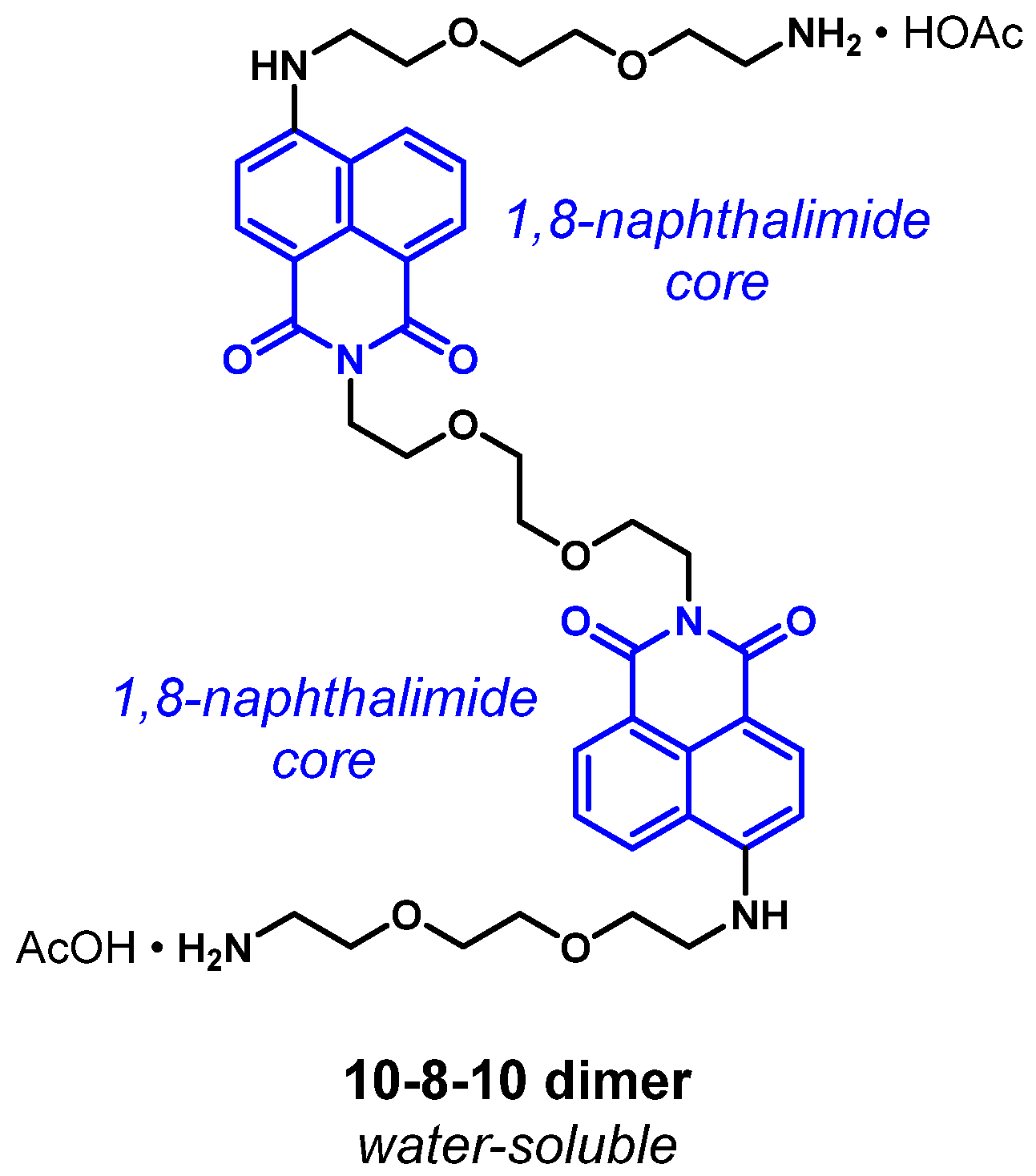
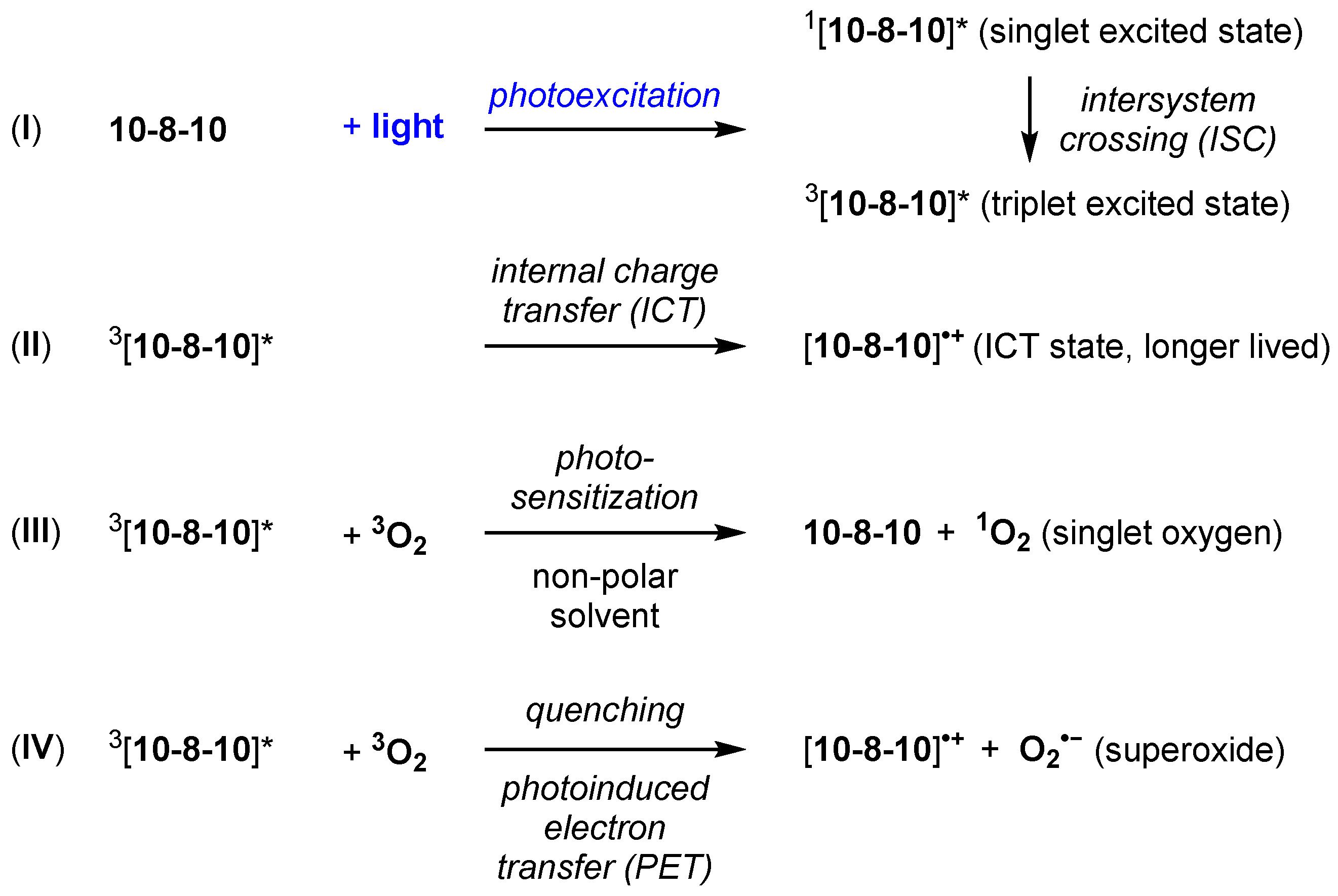
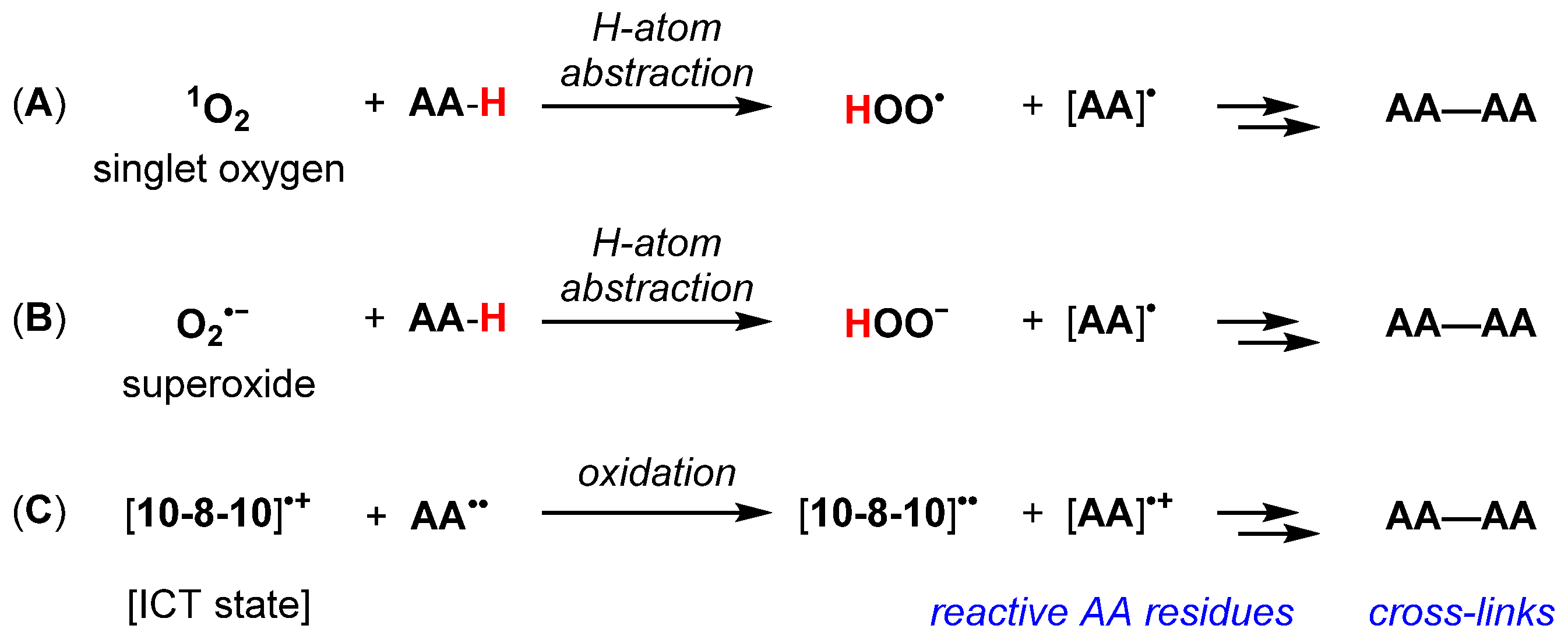



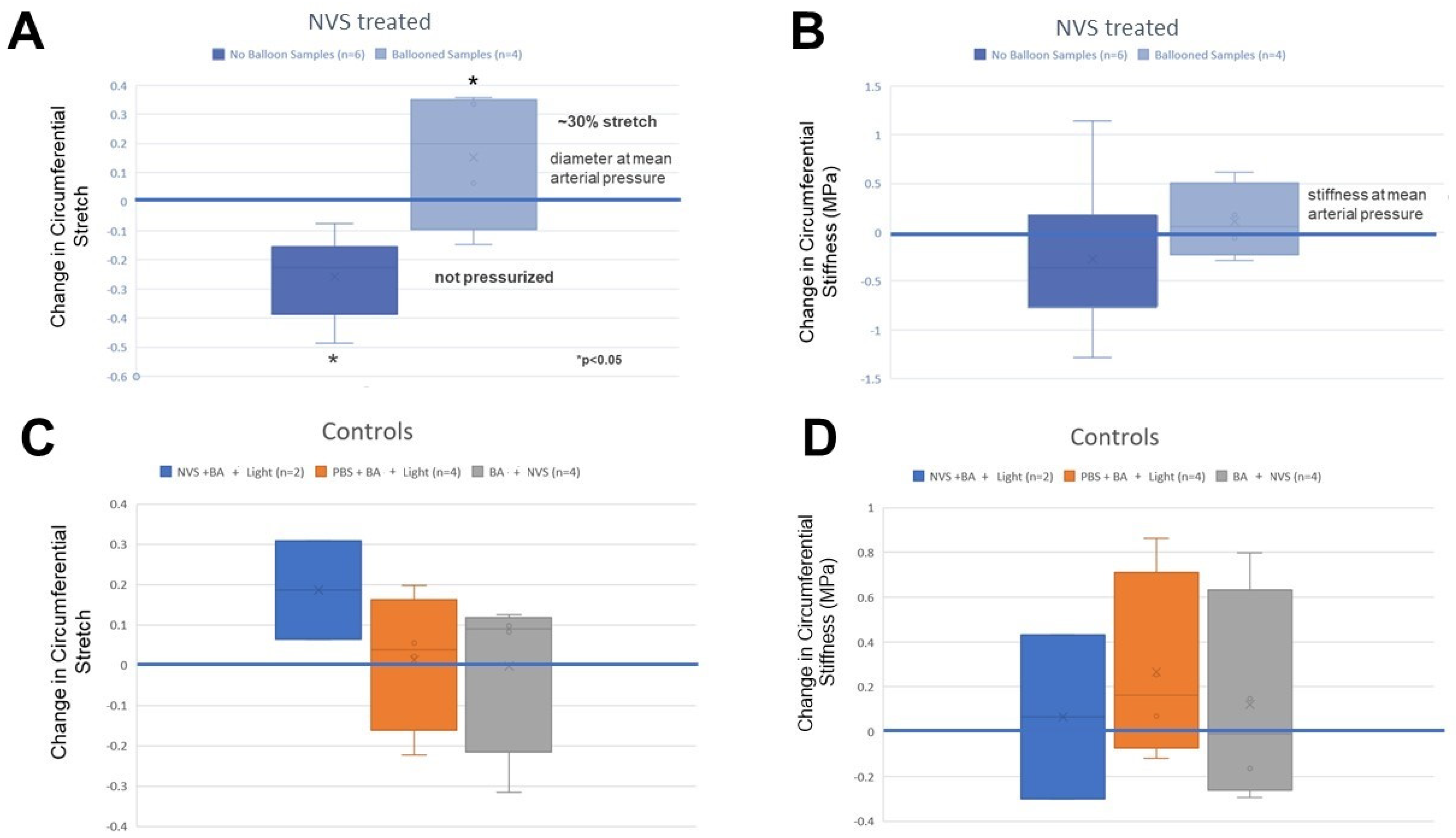
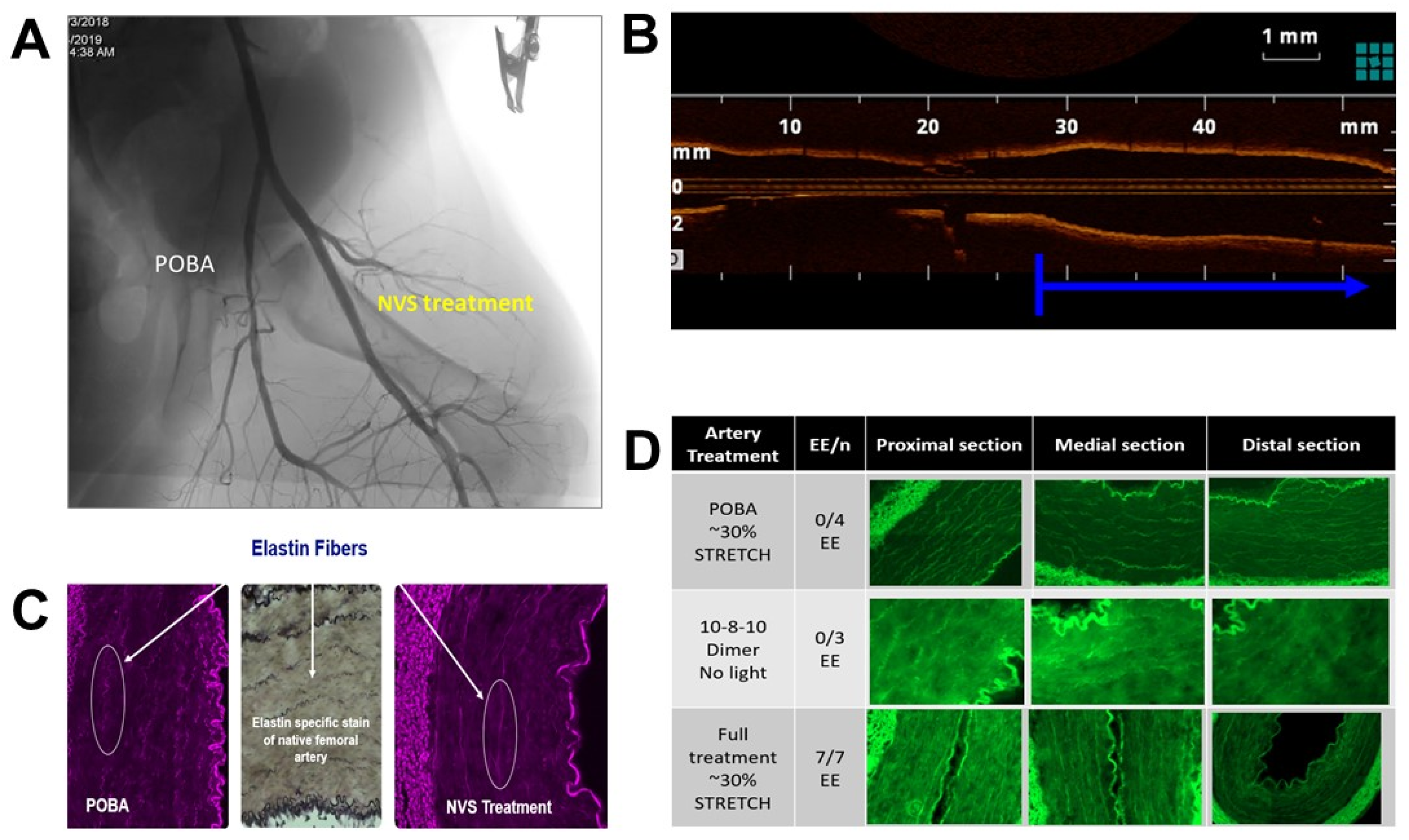
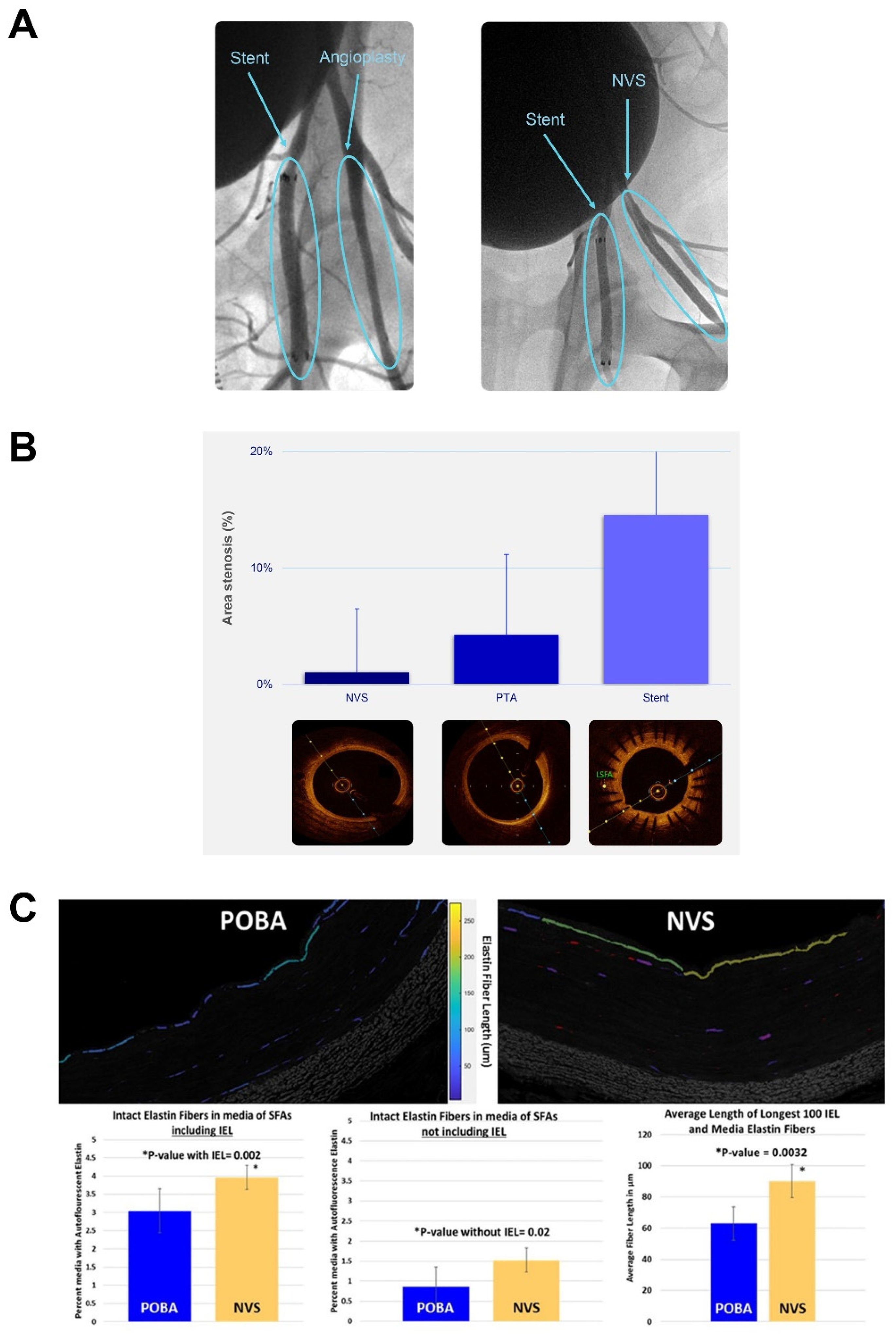
| 10-8-10 Dimer Solution Concentration (mM) | Time of 10-8-10 Dimer Solution Exposure | 10-8-10 Loading in Artery (ng/mg) * | Light Dose (J/cm2) ** | Luminal Gain (Pass Criteria > 16%) |
|---|---|---|---|---|
| 0.15 | 5 min | NT | 11 J/cm2–13 J/cm2 (188 mW/cm2 * 60 s = 11,280 mJ/cm2 or 11 J/cm2) | 8 ± 1 |
| 0.3 | 20 | 10 ± 1 | ||
| 0.6 | 65 | 14 ± 4 | ||
| 1.2 | 72 | 18 ± 7 | ||
| 2.5 | 155 | 22 ± 5 |
| 10-8-10 Dimer Solution Concentration (mg/mL) | Molecular Weight 10-8-10 Dimer (Dalton) | Concentration of 10-8-10 Dimer (mmol/mL) | Concentration of Peptide (mmol/mL) | Mole Ratio (10-8-10/Peptide) * | Light Dose (mJ/cm2) |
|---|---|---|---|---|---|
| 0.1 | 800 | 0.00013 | 0.0013 | 1:10 | 342 |
| 0.3 | 800 | 0.00038 | 0.0013 | 1:3 | 342 |
| 2.5 | 800 | 0.0031 | 0.0013 | 1:0.4 | 14,000 |
Publisher’s Note: MDPI stays neutral with regard to jurisdictional claims in published maps and institutional affiliations. |
© 2022 by the authors. Licensee MDPI, Basel, Switzerland. This article is an open access article distributed under the terms and conditions of the Creative Commons Attribution (CC BY) license (https://creativecommons.org/licenses/by/4.0/).
Share and Cite
Kauser, K.; Warner, K.S.; Anderson, B.; Keyes, E.D.; Hayes, R.; Kawamoto, E.; Perkins, D.; Scott, R.; Isaacson, J.; Haberer, B.; et al. Creating a Natural Vascular Scaffold by Photochemical Treatment of the Extracellular Matrix for Vascular Applications. Int. J. Mol. Sci. 2022, 23, 683. https://doi.org/10.3390/ijms23020683
Kauser K, Warner KS, Anderson B, Keyes ED, Hayes R, Kawamoto E, Perkins D, Scott R, Isaacson J, Haberer B, et al. Creating a Natural Vascular Scaffold by Photochemical Treatment of the Extracellular Matrix for Vascular Applications. International Journal of Molecular Sciences. 2022; 23(2):683. https://doi.org/10.3390/ijms23020683
Chicago/Turabian StyleKauser, Katalin, Kevin S. Warner, Blake Anderson, Edgar Dalles Keyes, RB Hayes, Eric Kawamoto, DH Perkins, Robert Scott, Jim Isaacson, Barb Haberer, and et al. 2022. "Creating a Natural Vascular Scaffold by Photochemical Treatment of the Extracellular Matrix for Vascular Applications" International Journal of Molecular Sciences 23, no. 2: 683. https://doi.org/10.3390/ijms23020683
APA StyleKauser, K., Warner, K. S., Anderson, B., Keyes, E. D., Hayes, R., Kawamoto, E., Perkins, D., Scott, R., Isaacson, J., Haberer, B., Spaans, A., Utecht, R., Hauser, H., Roberts, A. G., & Greenberg, M. (2022). Creating a Natural Vascular Scaffold by Photochemical Treatment of the Extracellular Matrix for Vascular Applications. International Journal of Molecular Sciences, 23(2), 683. https://doi.org/10.3390/ijms23020683






